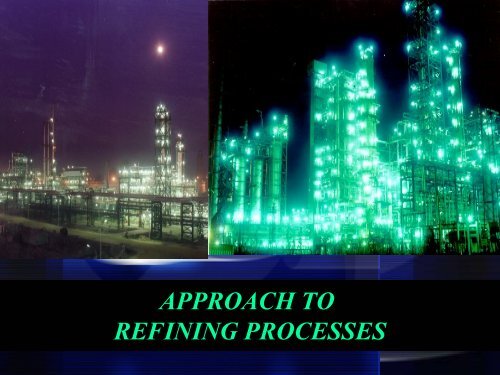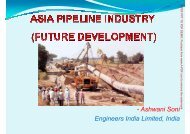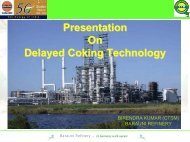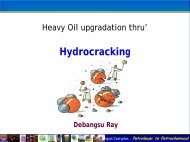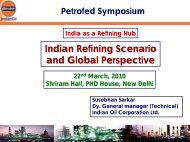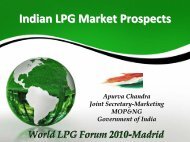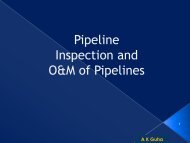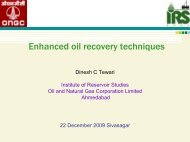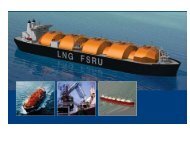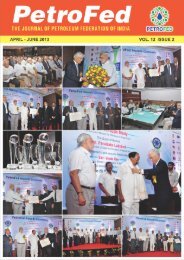APPROACH TO REFINING PROCESSES - petrofed.winwinho...
APPROACH TO REFINING PROCESSES - petrofed.winwinho...
APPROACH TO REFINING PROCESSES - petrofed.winwinho...
You also want an ePaper? Increase the reach of your titles
YUMPU automatically turns print PDFs into web optimized ePapers that Google loves.
<strong>APPROACH</strong> <strong>TO</strong><br />
<strong>REFINING</strong> <strong>PROCESSES</strong><br />
1
Beginning of Petroleum Refining in India<br />
In 1890s Crude Oil used to be<br />
distilled in DIGBOI in Cast<br />
Iron pans – called ‘Stills’.<br />
Bottom portion of one such<br />
still of 9 feet dia is still kept at<br />
Digboi Refinery.<br />
A refinery was commissioned<br />
in 1901 at Digboi with 500<br />
Barrels per Day capacity<br />
THE FIRST STILL LIES STILL
OUTLINE<br />
1. Introduction<br />
2. Physical Processes<br />
3. Thermal Processes<br />
4. Catalytic Processes<br />
5. Conversion of Heavy Residues<br />
6. Treatment of Refinery Gas Streams
INTRODUCTION<br />
Oil refining is a key activity in the CPI.<br />
Over 600 refineries worldwide have a total<br />
annual capacity of more than 3500 x 10 6<br />
tonnes.<br />
Goal of oil refining is mainly twofold:<br />
i. production of fuels for transportation, power<br />
generation and heating; and<br />
ii.<br />
production of raw materials for the CPI.<br />
Oil refineries are complex plants, but are<br />
relatively mature and highly integrated.
Overview<br />
After desalting and dehydration, crude is<br />
separated into fractions by distillation.<br />
The distilled fractions can not be used directly.<br />
The reason for such a complex set of<br />
processes is the difference between the crude<br />
oil properties and the needs of the market.<br />
Another reason for complexity is<br />
environmental. Legislation demands cleaner<br />
products and is the major drive for process<br />
improvement and development of novel<br />
processes.
Quality<br />
Control<br />
COMPLETE REFINERY<br />
Marketing<br />
Power &<br />
Utilities<br />
OM&S (Product Blending &<br />
Dispatch)<br />
Finishing<br />
Units<br />
Crude<br />
Oil<br />
Jetty /<br />
Pipeline<br />
OM&S<br />
Separation<br />
Units<br />
OM&S<br />
(Intermediates)<br />
Waste<br />
Treatment<br />
Round the clock operation<br />
Conversion<br />
Units<br />
Welfare /<br />
Admn.
Physical and Chemical processes<br />
Physical<br />
Thermal<br />
Chemical<br />
Catalytic<br />
Distillation<br />
Solvent extraction<br />
Propane deasphalting<br />
Solvent dewaxing<br />
Blending<br />
Visbreaking<br />
Delayed coking<br />
Flexicoking<br />
Hydrotreating<br />
Catalytic reforming<br />
Catalytic cracking<br />
Hydrocracking<br />
Catalytic dewaxing<br />
Alkylation<br />
Polymerization<br />
Isomerization
Flow scheme of a modern refinery
Desalting/dehydration<br />
Crude oil often contains water, inorganic salts, suspended<br />
solids, and water-soluble trace metals.<br />
Step 0 in the refining process is to remove these contaminants<br />
so as to reduce corrosion, plugging, and fouling of equipment<br />
and to prevent poisoning catalysts in processing units.<br />
The typical method of crude-oil desalting is electrostatic<br />
separation.<br />
In desalting, water<br />
and chemical<br />
surfactant<br />
(demulsifiers) are<br />
added to the crude,<br />
which is heated so that<br />
salts and other<br />
impurities dissolve or<br />
attach to the water;<br />
then held in a tank to<br />
settle out.
Desalting/dehydration<br />
The crude oil feedstock is heated to 110 – 150 °C to<br />
reduce viscosity and surface tension for easier mixing<br />
and separation of the water. The temperature is limited<br />
by the vapor pressure of the crude oil.<br />
High-voltage electrostatic charges are applied at the<br />
settling tank to concentrate suspended water globules<br />
in the bottom of the settling tank.
Crude distillation<br />
Step 1 in the refining process is the separation of crude oil<br />
into various fractions or straight-run cuts by distillation. The<br />
main fractions or "cuts" obtained have specific boilingpoint<br />
ranges and can be classified in order of decreasing<br />
volatility into gases, light distillates, middle distillates,<br />
heavy vacuum distillates and residuum.<br />
The desalted crude feedstock is preheated using<br />
recovered process heat.<br />
The feedstock then flows to a direct-fired crude charge<br />
heater then into the vertical distillation column just above<br />
the bottom, at pressure slightly above atmospheric and at<br />
temperatures ranging from 340-370°C (above these<br />
temperatures undesirable thermal cracking may occur).<br />
All but the heaviest fractions flash into vapor at the feedentry<br />
location of the column.
Liquid and vapor flows in a tray column
Crude distillation<br />
As the hot vapor rises in the tower, portions of the vapor are<br />
condensed at successively higher stages in the tower, and<br />
the various products – e.g., diesel, kerosene, gasoline – are<br />
drawn off as liquids (through side-draw strippers).<br />
Uncondensed vapours leave column<br />
overhead, are condensed outside and<br />
stored in overhead accumulator drum.<br />
Part of this liquid is refluxed back to the<br />
column at top, and part is withdrawn as<br />
the ‘top’ fraction.<br />
Heavy residuum is drawn out from<br />
column bottom.<br />
To further distill the residuum from the<br />
atmospheric tower, without thermal<br />
cracking, reduced pressure is required.<br />
The process takes place in vacuum distillation tower. The principles<br />
of vacuum distillation are same, except that larger diameter<br />
columns are used to maintain comparable vapor velocities at the<br />
reduced pressures.
Atmospheric & Vacuum Distillation Unit<br />
S<br />
LPG<br />
T<br />
A<br />
Pr= 40-60 mm Hg a<br />
T=200 Deg C<br />
Pre-topping<br />
Unstabilised<br />
Naphtha<br />
B<br />
Stabilized Naphtha<br />
Light Naphtha<br />
Heavy Naphtha<br />
To Steam Ejector<br />
LVGO<br />
LDO<br />
Crude Oil<br />
Desalter<br />
T=130-140<br />
Deg C<br />
Furnace<br />
T= 370 oC<br />
RCO<br />
Atmospheric<br />
Kero / ATF<br />
LGO<br />
HGO<br />
Furnace<br />
T= 415 oC<br />
Vacuum<br />
HVGO<br />
Vac Slop<br />
VR
Streams from Atm. Distillation<br />
Crude<br />
oil<br />
Stream<br />
b.p.,<br />
o<br />
C<br />
Application<br />
Key<br />
Property<br />
Treatment<br />
Gas Refinery fuel H 2 S Amine<br />
scrubbing<br />
LPG Domestic /<br />
Industrial fuel<br />
Naphtha 30 – 140 MS blend,<br />
feed for<br />
Petrochemical<br />
/ fertilzer<br />
Kerosine<br />
/ ATF<br />
140 – 270<br />
140 – 240<br />
Domestic fuel /<br />
Jet fuel<br />
Cu corrosion,<br />
Weathering<br />
Cu corrosion,<br />
Component<br />
analysis<br />
(PIONA)<br />
Smoke pt. /<br />
Freeze pt.,<br />
Ag corr.<br />
Gas Oil 240 – 370 Diesel fuel ‘S’ content,<br />
Cetane no.<br />
Caustic<br />
wash,<br />
Merox<br />
Catalytic<br />
reforming /<br />
isomerization<br />
Merox /<br />
Hydrotreatment<br />
Hydrotreatment<br />
Reduced<br />
crude<br />
> 370 Further<br />
conversion,<br />
Furnace Oil<br />
Vacuum<br />
distillation
Catalytic Reforming Reactions
Semi-regenerative Catalytic Reforming Unit<br />
Flow Scheme
Effect of process variables on Reforming
Continuous Catalytic Reforming Unit<br />
Flow Scheme<br />
LSRN (85-160)<br />
VBN<br />
NHDT<br />
Off Gas to<br />
FG system<br />
H2 RICH<br />
GAS <strong>TO</strong> PSA<br />
Off Gas to<br />
FG system<br />
COL OVHD<br />
RECEIVER<br />
Pr. 17.0<br />
kg/cm2g<br />
RGC<br />
SEPARA<strong>TO</strong>R<br />
Pr. 17.0<br />
kg/cm2g<br />
T =-10 deg c<br />
Recontacting drum<br />
S<br />
T<br />
A<br />
B<br />
I<br />
L<br />
I<br />
S<br />
E<br />
R<br />
LPG<br />
T=520-540 Deg C<br />
Regenerator<br />
Reformate to MS Pool<br />
via RSU
Diesel Hydro Desulphurisation (DHDS) Unit<br />
Fuel gas<br />
Off. gas<br />
H2 Recycle<br />
H2 Make<br />
Up<br />
Temp. 350<br />
Deg C<br />
High Pr.<br />
Separator<br />
Pr. 35-40<br />
kg/cm2g<br />
A<br />
b<br />
s<br />
or<br />
b<br />
er<br />
Lean<br />
Amine<br />
Rich<br />
Amine<br />
S<br />
T<br />
R<br />
I<br />
P<br />
P<br />
E<br />
R<br />
COL OVHD<br />
RECEIVER<br />
Wild<br />
naphtha<br />
Steam<br />
Feed<br />
Furnace<br />
Reactor<br />
Desulphurized<br />
Diesel
DHDS / DHDT :<br />
Product Yields & Operating Conditions<br />
1. Typical Product Yields, wt.% on feed<br />
No. Products DHDS DHDT End Use<br />
1. Off Gas 1.4 1.8 Refinery Fuel Gas<br />
after Amine Wash<br />
2. Wild<br />
Naphtha<br />
1.3 2.0 Naphtha after<br />
stabilization<br />
3. Diesel 97.2 96.1 Diesel Pool<br />
2. Typical Operating Conditions<br />
DHDS<br />
DHDT<br />
Temperature, o C 340 – 390 330 – 370<br />
System Pressure, kg/cm 2 (g) 40 – 50 90 – 105
Secondary processing of VDU streams<br />
No VDU Product Quality Processing<br />
1. VGO & SO High ‘S’. Low<br />
Cetane no.<br />
Hydrotreatment (DHDT) for Sulphur and<br />
Cetane No./LOBS<br />
2. LO High ‘S’. Heavy<br />
Hydrocarbons<br />
3. IO High ‘S’. Heavy<br />
Hydrocarbons<br />
4. HVGO High ‘S’. Heavy<br />
Hydrocarbons<br />
5. Vacuum Slop Heavy<br />
Hydrocarbons,<br />
Fuel oil Product<br />
Fluid Catalytic Cracking (FCC) unit /<br />
Hydro-Cracking Unit(HCU) / LOBS<br />
Fluid Catalytic Cracking (FCC) unit /<br />
Hydro-Cracking Unit(HCU) / LOBS<br />
Fluid Catalytic Cracking (FCC) unit /<br />
Hydro-Cracking Unit(HCU) / LOBS<br />
Visbreaker unit / Coker/ Fluid Catalytic<br />
Cracking (FCC) unit<br />
6. Vacuum<br />
Residue<br />
Residue<br />
Bitumen Blowing Unit / VBU / Coker/<br />
Propane De-Asphalting (PDA) unit
Lube Base Oil Processing<br />
Crude Selection<br />
Multi-step manufacturing process
BASE OIL COMPONENT PROPERTIES<br />
PROPERTY<br />
N-<br />
PARAFFINS<br />
ISO-<br />
PARAFFINS<br />
NAPHTHENES<br />
AROMATICS<br />
VI HIGH HIGH MEDIUM LOW<br />
POUR PT HIGH LOW LOW LOW<br />
OXIDATION<br />
STABILITY<br />
GOOD GOOD FAIR LOW<br />
THERMAL<br />
STABILITY<br />
GOOD GOOD FAIR LOW
Lube Base Oil Processing Philosophy<br />
Crude<br />
oil<br />
Atmospheric distillation<br />
Gas<br />
Naphtha<br />
Kero<br />
Diesel<br />
RCO<br />
VGO<br />
Vacuum distillation<br />
VR<br />
Propane De-<br />
Asphalting<br />
Properties controlled by Process Units<br />
KV,<br />
Flash Point<br />
VI, CCR Pour Point<br />
Vacuum<br />
Distillates<br />
DAO<br />
Solvent Extraction<br />
(Furfural & NMP)<br />
Waxy<br />
Raffinate<br />
De-waxed<br />
oils<br />
Colour &<br />
Stability<br />
H 2<br />
Solvent<br />
Dewaxing<br />
Unit<br />
VI,Pour Point,<br />
Colour&Stability<br />
100N<br />
Catalytic 150N<br />
Dewaxing 500N<br />
H Unit 150BS<br />
2<br />
Hydrofinishing<br />
Group I<br />
LOBS<br />
150N<br />
500N<br />
HN<br />
BN/150BS<br />
Group II LOBS
EXTRACTION UNIT<br />
Feed stock: - Vac. Distillates<br />
ex VDU<br />
-DAO ex PDA<br />
Purpose : Extraction of<br />
aromatics – using Furfural as<br />
solvent – to improve VI of<br />
LOBS.<br />
Products : - Raffinate<br />
- Aromatic extract.<br />
Quality Monitoring:<br />
Raffinate: K.V (100 oC), RI,<br />
Extract : Density.
FURFURAL EXTRACTION SCHEME<br />
TREATING SECTION<br />
EXTRACT E RECOVERY<br />
SECTION<br />
RAFFINATE RECOVERY<br />
SECTION<br />
SOLVENT PURIFICATION<br />
DEAERATED<br />
FEEDS<strong>TO</strong>CK<br />
E<br />
X<br />
T<br />
R<br />
C<br />
T<br />
O<br />
R<br />
HP<br />
MP<br />
LP<br />
Flash<br />
Tower<br />
STEAM<br />
VAC<br />
S<br />
T<br />
R<br />
I<br />
P<br />
P<br />
E<br />
R<br />
STEAM<br />
VAC<br />
FURFURAL<br />
A<br />
T<br />
O<br />
W<br />
E<br />
R<br />
B<br />
T<br />
O<br />
W<br />
E<br />
R<br />
WASTE<br />
WATER<br />
R/D RAFFINATE<br />
R/D EXTRACT<br />
FURFURAL
SOLVENT DE-WAXING UNIT<br />
Objective<br />
To remove paraffinic<br />
hydrocarbons so that<br />
LOBS is suitable for low<br />
temp. application<br />
The Process<br />
Extraction and<br />
crystallization to achieve<br />
de-waxing, followed by<br />
Filtration & Solvent<br />
Recovery<br />
Solvent : MEK & Toluene in<br />
equal proportions.<br />
Toluene is oil solvent &<br />
MEK is anti wax solvent.<br />
Feed characterized by<br />
Density, Kin. Visc & RI<br />
LOBS characterized by KV,<br />
P.Pt., VI, Fl.Point,
General Effects of Refining on Main<br />
Characteristics of Lube Oil Fractions<br />
Main<br />
Characteristics<br />
General Range of Changes Brought about<br />
Solvent<br />
Refining<br />
Dewaxing<br />
Hydro<br />
finishing<br />
Viscosity ↓ --<br />
V.I. ↓ --<br />
Pour Point ↓ →<br />
C.C.R ↓ -- ↓<br />
Acidity ↓ -- ↓<br />
Sulphur ↓ -- ↓<br />
Colour ↓ -- ↓
CATALYTIC DE-WAXING UNIT<br />
SIMPLIFIED PROCESS SCHEME<br />
RECYCLE<br />
HYDROTREATING<br />
MSDW<br />
PURGE<br />
HYDROFINISHING<br />
FEED<br />
SEPARA<strong>TO</strong>R<br />
MAKE UP<br />
HYDROGEN<br />
HDT. EFFLUENT<br />
STRIPPING & SCRUBBING<br />
NAPHTHA<br />
DIESEL<br />
PRODUCT<br />
FRACTIONATION<br />
SECTION<br />
GROUP II / GROUP III LOBS PRODUCT
Fluidized Catalytic Cracking Unit (FCCU)<br />
Objective : To convert Heavy Vacuum Gas Oil<br />
to valuable distillates like LPG, Gasoline, Diesel<br />
by catalytic cracking in fluidized bed.<br />
Feed : VGO/RCO/VR/HydroCracker Bottom.<br />
Catalyst : Silica & Alumina Zeolite Structure
FCCU Product Qualities & End Uses<br />
No Product Qualities End Use<br />
1. Gas H2S rich Off. Gas Refinery Fuel Gas after<br />
Amine scrubbing<br />
2. LPG H2S, Mercaptons,<br />
olefins like<br />
Propylene/Butylene<br />
3. Gasoline High Octane No. and<br />
high Olefin contents<br />
To LPG Pool/<br />
Petrochemical feedstock<br />
MS Pool<br />
4. HNaphtha<br />
+ LCO<br />
Low Cetane no. High<br />
‘S’, Unsaturates<br />
Diesel Pool after<br />
Hydrotreatment<br />
5. CLO High Aromatics, Good<br />
Cutter Stock<br />
Fuel Oil
Yield pattern of Different Types of FCC<br />
VGO FCC RFCC INDMAX PETROFCC<br />
FEED VGO VGO+VR VGO+VR VGO<br />
FEED QUALITY<br />
CCR, WT% 0.74 4.06
Hydro-cracking Unit<br />
Objective<br />
: To convert Heavy Vacuum<br />
Gas Oil to valuable distillates like LPG, Naphtha, ATF,<br />
Kerosene and Diesel.<br />
Feed<br />
: VGO / Coker Products<br />
Operating Conditions<br />
- Temperature range : 370 – 420 o C<br />
- System Pressure : 160 – 170 kg/cm 2 (g)<br />
Catalyst : - Ni/Mo oxides for hydro-treating<br />
- Ni/Mo/W(Tungsten) for Hydro-cracking
Hydro Cracker Unit Flow Scheme<br />
Ex<br />
MPU<br />
Makeup H2<br />
MUC<br />
R-1 R-2<br />
RGC<br />
HP Amine<br />
Gas & LN to Light<br />
End<br />
Recovery Section<br />
PSA<br />
G-1<br />
V-1<br />
F-1<br />
Wash Water<br />
Amine<br />
Scrubber<br />
Heavy<br />
Naphtha<br />
HVGO<br />
Feed<br />
Filter<br />
E-1<br />
Feed Preheat Ex<br />
Hydrocracking<br />
Reactor<br />
PRT<br />
V-2 V-3<br />
V-8<br />
V-9<br />
MPU<br />
To MUG<br />
F-2<br />
CR<br />
Unconverted<br />
Oil<br />
ATF/Kero<br />
Diesel
HCU Product Qualities & End Uses<br />
No. Product Qualities End Uses<br />
1. Gas H 2 S rich Off. Gas Refinery Fuel Gas<br />
after Amine Wash<br />
2. LPG H 2 S Contents LPG Pool after caustic<br />
wash<br />
3. Naphtha low Octane No. and low<br />
‘S’ contents<br />
Hydrogen Unit Feed /<br />
CRU feed/ Naphtha<br />
4. ATF /<br />
Kero<br />
Low ‘S’ and Low<br />
Aromatics<br />
ATF/ Kero.<br />
5. Diesel Low ‘S’ and High Cetane Euro – IV/ III Diesel<br />
6. Unconverted<br />
Oil<br />
Low ‘S’, High Saturates<br />
FCCU Feed
Delayed Coking Process<br />
Feedstock<br />
: Vacuum Residue<br />
Good process for increasing distillates and minimizing<br />
black oil production.<br />
Products Yields :<br />
Gas+loss 8%<br />
LPG 4%<br />
Naphtha 6%<br />
Gas oil 43%<br />
FO 11%<br />
RPC 28%<br />
Gas oil & Naphtha need further treatment.
Delayed Coking Unit (DCU) flow scheme<br />
Gas/LPG<br />
FEED<br />
F<br />
SR<br />
A<br />
O<br />
C<br />
AT<br />
KI<br />
O<br />
EN<br />
RA<br />
T<br />
O<br />
R<br />
Naphtha<br />
Kero<br />
Gas Oil<br />
Fuel Oil<br />
S<br />
E<br />
P<br />
A<br />
R<br />
A<br />
T<br />
O<br />
R<br />
RFO<br />
C<br />
O<br />
K<br />
E<br />
C<br />
H<br />
A<br />
M<br />
B<br />
E<br />
R<br />
C<br />
O<br />
K<br />
E<br />
C<br />
H<br />
A<br />
M<br />
B<br />
E<br />
R<br />
Pre heat Exchanger<br />
Furnace<br />
T=505 0 C
Delayed Coker<br />
Products Qualities & End Uses<br />
No Product Qualities End Uses<br />
1. Gas H2S rich Off Gas Refinery FG after<br />
Amine Wash<br />
2. LPG Mercaptons, unsaturates LPG after Merox /<br />
Caustic wash<br />
3. Naphtha Low Octane, High Olefins NHDT / DHDT feed<br />
4. Kerosene High unsatuartes DHDT Feed<br />
5. Gas Oil Low Cetane No. and high DHDT / HCU feed<br />
unsaturates<br />
6. Fuel Oil Good cutter stock Fuel Oil<br />
7. Coke Low ash, Sulphur content<br />
depends on feed ‘S’<br />
Gasification/ cement<br />
ind. /Electrode<br />
Preparation
Sulphur Recovery - schematic
Flow scheme of a modern refinery
Thank you<br />
Thank you
BASIC REFINERY OPERATIONS<br />
Hydrocarbon molecules in crude do NOT meet customer needs<br />
SEPARATION <strong>PROCESSES</strong><br />
(Primary Processes)<br />
Segregate the molecules<br />
CONVERSION <strong>PROCESSES</strong><br />
(Secondary Processes)<br />
Rearrange the molecules<br />
FINISHING <strong>PROCESSES</strong><br />
(Secondary Processes)<br />
Remove Contaminants<br />
MARKETABLE PRODUCTS


